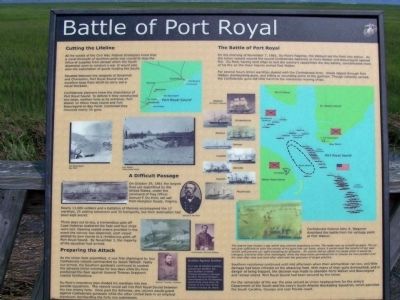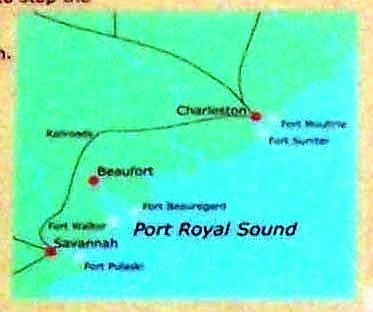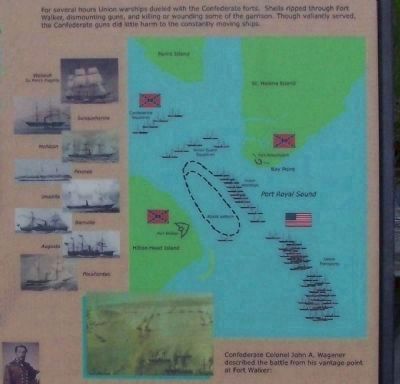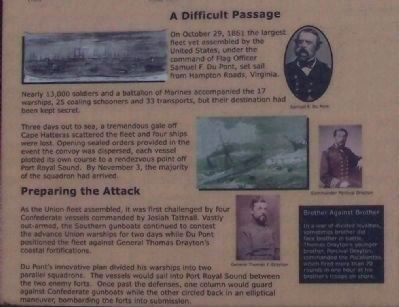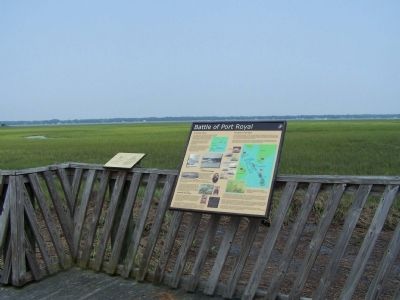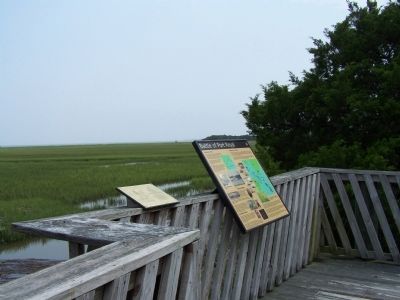Parris Island in Beaufort County, South Carolina — The American South (South Atlantic)
Battle of Port Royal
For several hours Union warships dueled the Confederate forts. Shells ripped through Fort Walker, dismounting guns, and killing or wounding some of the garrison. Though valiantly served, the Confederate guns did little harm to the constantly moving ships.
Cutting the Lifeline
At the outset of the Civil War, Federal strategists knew that a naval blockade of southern ports was crucial to stop the influx of supplies from abroad which the South depended upon to conduct war. It would also slow the exportation of goods funding the South.
Situated between the seaports of Savannah and Charleston, Port Royal Sound was an excellent base from which to carry out a naval blockade.
Confederate planners knew the importance of Port Royal Sound. To defend it they constructed two large, earthern forts at its entrance; Fort Walker on Hilton Head Island and Fort Beauregard on Bay Point. Combined they mounted nearly 50 guns.
[ Picture included : Fort Beauregard Bay Point and Fort Walker Hilton Head Island ]
A Difficult Passage
[ Pictures included ]
On October 29, 1861 the largest fleet yet assembled by the United States, under the command of Flag Officer Samuel F. Du Pont, set sail from Hampton Roads, Virginia.
Nearly 13,000 soldiers and Marines accompanied the 17 warships, 25 coaling schooners and 33 transports, but their destination had been kept secret.
Three days out to sea, a tremendous gale off Cape Hatteras scattered the fleet and four ships were lost. Opening sealed orders provided in the event the convoy was dispersed, each vessel plotted its own course to a rendezvous point off Port Royal Sound. By November 3, the majority of the squadron had arrived.
Preparing the Attack
As the Union fleet assembled, it was first challenged by four Confederate vessels commanded by Josiah Tattnall. Vastly out-armed, the Southern gunboats continued to contest the advance Union warships for two days while Du Pont positioned the fleet against General Thomas Drayton's coastal fortifications.
Du Pont's innovative plan divided his warships into two parallel squadrons. The vessels would sail into Port Royal Sound between two enemy forts. Once past the defenses, one column would guard against Confederate gunboats while the other circled back in an elliptical maneuver, bombarding the forts into submission. [ Picture included ]
[Other Pictures include: Wabash, Du Pont's flagship, Susquehanna,Mohican, Pawnee, Unadilla, Bienville, Augusta, Pocahontas, also Samuel F. Du Pont,Commadore Percival Drayton.and General Thomas Drayton ]
Brother Against Brother
In a war of divided loyalties, sometimes brother did face brother in battle. Thomas Drayton's younger brother, Percival Drayton, commanded the Pocahontas, which fired more than 70 rounds in one hour at his brother's troops on shore.
Confederate Colonel John A. Wagener described the battle from his vantage point at Fort Walker: [ Picture included ]
The enemy had chosen a day which was entirely propitious to him. The water was smooth as glass. The air was just sufficient to blow the smoke of his guns into our faces, where it would meet the column of our own smoke and prevent our sight excepting by glimpses. No sooner did we obtain his range when it would be changed, and time after time rechanged, while the deep water permitted him to choose his own position and fire shot after shot and shell after shell with the precision of target practice.
Southern resistance continued until mid afternoon when their ammunition ran low, and little damage had been inflicted on the attacking fleet. With many of their guns dismounted,
and in danger of being trapped. the decision was made to abandon Forts Walker and Beauregard and retreat inland. Port Royal Sound had been secured by the Union.
For the remainder of the war the area served as Union headquarters for the army's Department of the South and navy's South Atlantic Blockading Squadron, which patrolled the South Carolina, Georgia and east Florida coast.
Erected by U.S. Marine Corps Recruit Depot Parris Island.
Topics. This historical marker is listed in these topic lists: War, US Civil • Waterways & Vessels. A significant historical month for this entry is October 1899.
Location. 32° 18.321′ N, 80° 40.546′ W. Marker is on Parris Island, South Carolina, in Beaufort County. Marker can be reached from Belleau Wood Road when traveling east. East end of Belleau Wood Rd at the end of the boardwalk U.S. Marine Corps Recruit (Training) Depot, Parris Island. Touch for map. Marker is in this post office area: Parris Island SC 29905, United States of America. Touch for directions.
Other nearby markers. At least 8 other markers are within walking distance of this marker. Parris Island Lighthouses (within shouting distance of this marker); Lighthouse Keepers Home (within shouting distance of this marker); a different marker also named Parris Island Lighthouses (within shouting distance of this marker); Aqui Estuvo España (within shouting distance of this marker);
Parris Island Indians (within shouting distance of this marker); The First Inhabitants (about 300 feet away, measured in a direct line); Parris Island Plantations (about 300 feet away); Jean Ribault Monument (about 300 feet away). Touch for a list and map of all markers in Parris Island.
Regarding Battle of Port Royal. Thomas Fenwick Drayton; Brigadier-General, C.S.A. and his brother Commodore Percival Drayton, U.S.N., Captain of U.S.S. Hartford, and later the first Chief of Naval Operations.The brothers met at the outbreak of hostilities, shook hands, and each went the way his conscience directed.
Thomas elected to defend his state. Percival to follow his flag.
On November 7, 1861 the brothers met in battle. Commander Percival Drayton, on the gunboat Pocahontas, attacked Fort Walker on which General Thomas Drayton was in command.
Related markers. Click here for a list of markers that are related to this marker. More about Battle Of Port Royal Sound
Also see . . . The Battle of Port Royal. one of the earliest amphibious operations of the American Civil War, in which a United States Navy fleet and United States Army expeditionary
force captured Port Royal Sound, South Carolina
•••
The main body consisted of nine ships with guns and one without. In order, they were flagship Wabash, Susquehanna, Mohican, Seminole, Pawnee, Unadilla, Ottawa, Pembina, Isaac Smith, and Vandalia. Isaac Smith had jettisoned her guns during the storm, but she would now contribute by towing the sailing vessel Vandalia. Five gunboats formed the flanking column: Bienville, Seneca, Penguin, Curlew, and Augusta. Three other gunboats, R. B. Forbes, Mercury, and Penguin remained behind to protect the transports. (Submitted on June 30, 2009, by Mike Stroud of Bluffton, South Carolina.)
Credits. This page was last revised on June 16, 2016. It was originally submitted on June 30, 2009, by Mike Stroud of Bluffton, South Carolina. This page has been viewed 1,615 times since then and 41 times this year. Photos: 1, 2, 3, 4, 5, 6. submitted on June 30, 2009, by Mike Stroud of Bluffton, South Carolina. • Craig Swain was the editor who published this page.
